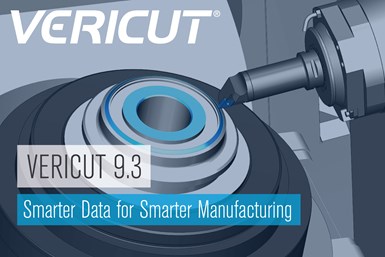Vericut 9.3 Features Upgraded Connectivity
Vericut 9.3 aims to create more efficient manufacturing processes with features that bring in data around the machine, the tools and the stock to improve simulation and the overall manufacturing workflow.
Share




CGTech announces the latest release of Vericut, Version 9.3. Vericut is an industry leader in machine simulation, verification and optimization for all types of CNC machining, additive and hybrid manufacturing processes. The software operates independently, but also integrates with all leading CAM systems.
According to CGTech, Vericut 9.3 focuses on creating more efficient manufacturing processes with features that bring in data around the machine, the tools and the stock to improve simulation and the overall manufacturing workflow. Improvements have been made to strengthen Vericut’s core, which include improving collision checking, increasing the limit on axes per subsystem and more. Cutting tool data in the Tool Performance Database and machine monitoring are a few of the notable changes in this version. CGTech says hundreds of customer-driven changes and improvements have also been addressed in this latest release.
Vericut’s integrated optimization module, Vericut Force, has also received additional features and enhancements in 9.3. Alongside improvements to core features and functionality, deflection calculations have changed to account for the entire rotating tool assembly, where previous versions only accounted for solid round tools with holders. This change in deflection, along with cutting tool data and information about stock material, is said to improve part surface finish, ensure the part meets the appropriate dimensions and extend cutter life.
Vericut’s Assembly Manager enables users to create and manage portions of their NC machines such as rotary table configurations, angle heads for machining, robot end effectors or various workholding setups with fixtures and workpieces to be machined. The library of assemblies saves programmer time since they are easily accessed by others, and for repeated use in new Vericut projects.
With improvements made to Force, users can reportedly achieve better machined part quality and longer tool and spindle bearing life. Deflection calculations have been updated to account for the entire rotating tool assembly, including indexable insert mills and model file cutters. Users can also add volume removal rate (VRR) limits to all cutters. Analysis and optimization for solid round tools and complex cutters has also been added.
Vericut’s Tool Manager now includes a Tool Performance Database (TPD) that suggests starting spindle speed and feed rates values to use with cutters in a wide range of stock materials. This data works with Machining Optimization Data (MOD) in Vericut’s Tool Manager. MOD displays a table of spindle speeds and feed rates that helps programmers choose appropriate cutting speeds and chip thickness values based on the cutting tool used and stock material being machined.
The first connective ability being released with Vericut 9.3 is Pre-Check, which obtains data from machines to ensure Vericut’s virtual machine is the best possible “twin,” and validate the job setup information on the machine matches what was verified in Vericut. Users can identify key differences so they know exactly what will happen prior to running the part on their machine.
Related Content
-
Tips for Designing CNC Programs That Help Operators
The way a G-code program is formatted directly affects the productivity of the CNC people who use them. Design CNC programs that make CNC setup people and operators’ jobs easier.
-
ERP Provides Smooth Pathway to Data Security
With the CMMC data security standards looming, machine shops serving the defense industry can turn to ERP to keep business moving.
-
5 Tips for Running a Profitable Aerospace Shop
Aerospace machining is a demanding and competitive sector of manufacturing, but this shop demonstrates five ways to find aerospace success.
























.jpg;maxWidth=300;quality=90)

